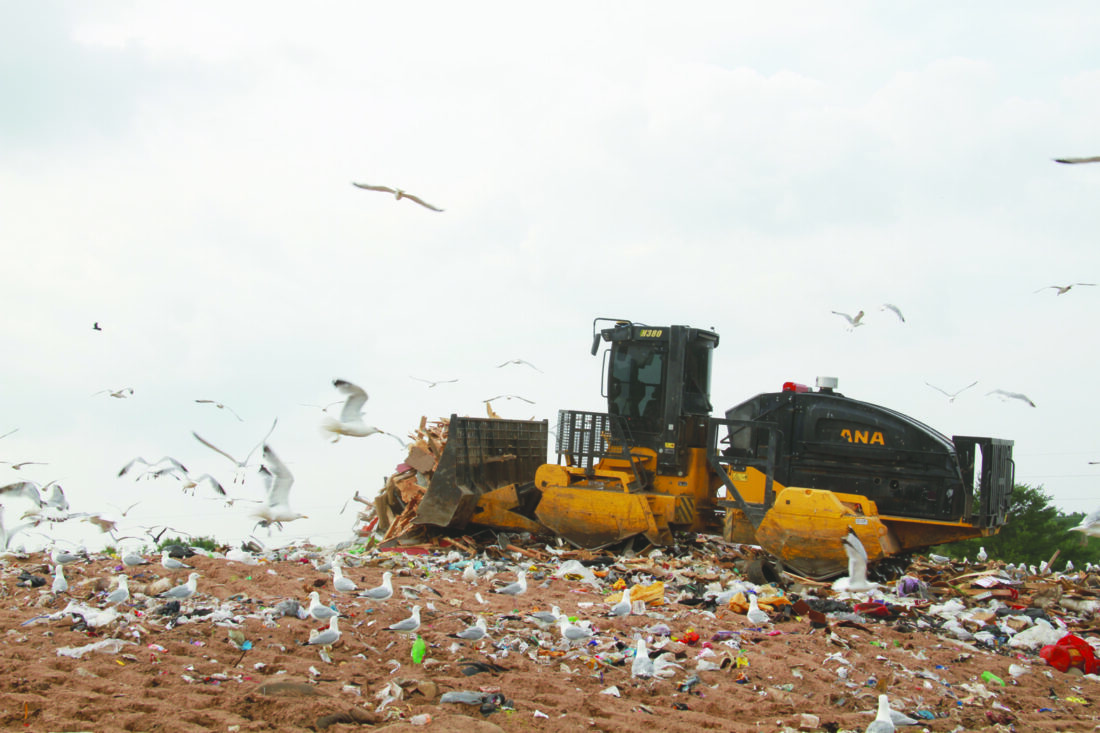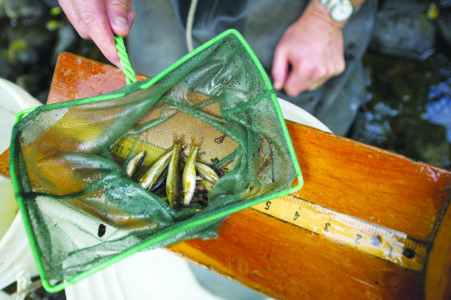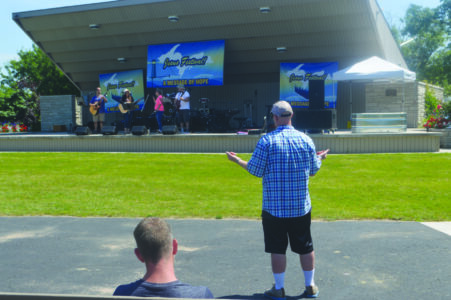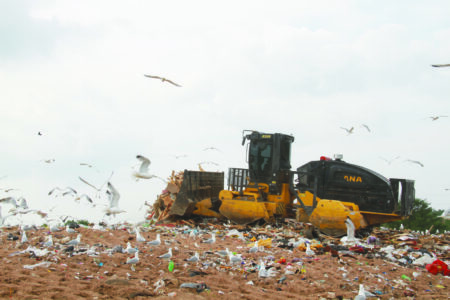Business Profile: Taking care of trash no easy task

R. R. Branstrom | Daily Press A Delta Solid Waste Management Authority (DSWMA) equipment operator compacts material in the sixth cell of the Delta County Landfill amidst many seagulls.
DANFORTH — Although there were a number of conflicts when talk of a county-wide landfill was underway in the 1970s, the place finally decided upon and opened in 1985 has remained as the destination for Delta County’s solid waste. As they did during the planning and building process, regulations surrounding disposal continue to evolve. For instance, the Department of Environment, Great Lakes, and Energy (EGLE) is currently incentivizing methods for greater recycling to cut back on overall waste.
The Delta Solid Waste Management Authority, which began as an ad hoc committee, has operated under Delta County since 1985 and runs the landfill, recycling center and compost site in Danforth. Before the current site became the landfill for all Delta County, there were a number of smaller dump sites.
“The old open garbage dumps, of which there were many in the Upper Peninsula before 1965, is actually a high cost and ineffective method of disposal… polluting, stinking areas brought land values down in a wide area around them; whereas the sanitary landfill method now required by the state statute keeps the refuse covered daily with soil and reduces its offensive and polluting aspects,” wrote the Daily Press in 1971, summarizing a presentation by Michigan Department of Health sanitarian Donald Veeser.
Over the next several years, Delta County discussed building a new county-wide one. Years of meetings and changing plans ensued.
The Department of Natural Resources (DNR) took over the management of sanitary landfills from the Department of Health in 1973. They changed specifications, not only making both Gladstone and Esky’s landfills noncompliant, but also increasing the costs of building a new one. Delta County sued the DNR, arguing that according to the Headlee Amendment, the State of Michigan had to provide funding before enforcing new regulations. The county won the case, but still struggled to move forward.
After its own landfill near the airport was ordered closed in 1979 because of seagulls creating a danger to planes, the City of Escanaba began to send their solid waste to Gladstone’s landfill– which had also been unlicensed since 1974. Twelve other townships in the county also used the Gladstone dump. However, by 1981, time had run out more than once. Besides the fact that the DNR was threatening the closure of the Gladstone dump due to claims of contaminated groundwater, the landfill was reaching capacity.
Though site clearing and minor construction like drainage ditch digging had begun at the property near the Danforth ski hill several years prior (in ’79), funding shortages, a failed contract with a private firm and the debacle with the state had stalled its development for some time.
In early 1982, a special county-appointed ad hoc landfill committee recommended the development of two types of landfills in Danforth. One would have the required liners to prevent leachate into groundwater; the other was to be for metals and non-contaminating construction waste. It was also this committee that advised the appointment of a management authority for the landfill.
When a county landfill still had not been built two years later, the Gladstone City Commission finally voted that its landfill, which had already been expanded and outlived its expected days, would be closed to those outside Gladstone in November 1984. It was a wake-up call and kick to action for the rest of the county.
By that July, the townships and cities in Delta County had agreed to share construction costs at Danforth and use a baler at the site to save space. Another space-saving solution would be recycling.
The Delta County Board adopted articles of incorporation for a Delta Solid Waste Management Authority (DSWMA) on Oct. 9, 1984. Representatives from all participating townships and cities (the Village of Garden, Fairbanks Township and Garden Township opted out) sat on the authority, which had its first meeting Jan. 16, 1985.
U.P. Engineering and Architectural Associates was hired to engineer the project. Ness Contracting and Sales won the bid to build the baler, and Bacco Construction of Iron Mountain completed construction work for the landfill, including the installation of two 6,000 tanks for leachate collection.
When it was time to appoint someone to operate the landfill, the DSWMA hired U.P. Engineering and Architectural Associates for the job for at least the first year.
The Delta County Landfill opened for use in December 1985.
The landfill area is comprised of multiple “cells,” units within the larger whole. Most modern landfills operate this way for efficient use of space and safe disposal.
The cells are lined with layers (of geosynthetic clay, membrane liner, composite drainage material, soil) designed to be impermeable, so that chemicals may be contained and kept separate from soil and groundwater. Leachate — water runoff that has touched the landfill and possibly flowed through rubbish — is collected and treated.
“We’re lucky enough that we worked with the City of Escanaba. We paid for the sewer to come down this road so we can pump our leachate right into the sewer, and it goes to the treatment plant,” said DSWMA Administration Manager Terri Rabitoy.
Water wells around the facility are regularly monitored. One of the tasks of Operations Manager Dave Lundquist is to pull water samples and send them off to be tested. DSWMA works with WSP (Engineering) and ALS Laboratories for the process.
Methane gases at the landfill are collected and burned off, Rabitoy said.
At the Delta County Landfill, only a relatively small section is in use at a given time, reducing the active area — which legally must be covered with six inches of cover daily. Cover may be earth or compost.
As newer cells fill up, they can be merged with old, covered cells. The portions currently utilized — meaning actively being dumped in and compacted and covered — are 6A and half of 6B, while cells 3, 4 and 5 are mostly full and have been allowed to grow over with hearty vegetation on top.
Active cells are continually compacted daily to conserve airspace. There are only so many cubic yards of airspace allotted before a landfill is considered at capacity.
“When people are paying to dump garbage here, they’re buying airspace, basically,” Lundquist explained. “So the more garbage we can cram into one cubic foot of airspace, the better.”
He spoke while watching trucks from Soo Hill Sanitation and U-Call We Haul dump loads in cell 6; nearby, a DSWMA equipment operator drove a compactor repeatedly over a taller heap to pack it down.
There are 12 employees at DSWMA, just over half of them full-time. Besides the managers, there are equipment operators, recycling center staff, scale attendants and a paper-picker.
“We have to keep the paper picked that blows out of the landfill. That’s a regulation; we’ll be out of compliance if we don’t have it clean around here,” Rabitoy said.
There is also Winnie, the lovable office cat, famous to those who frequent the dump to drop off waste and/or recyclables.
Cardboard, paper, plastics numbered one through seven, and aluminum and steel are all taken at Delta Wide Recycling — the name of the recycling arm at DSWMA’s facility. It costs county residents nothing to drop off most household recyclables.
Exceptions to free recycling dropoff are a few large and hazardous items — for example, standard tires usually cost $4 to bring in but are currently $2 thanks to a grant;, oil-based paints are $4 per gallon, four-foot fluorescent bulbs are $0.50, and mattresses cost $20 for any size.
Some items collected are not truly ready to be waste yet. In the building where recycling is dropped off, a small room holds partially-used cleaning products and paints that are free for the taking.
Rabitoy said that DSWMA is trying to encourage people to recycle more, but citizens must be informed on the proper way to do so.
“Our contamination rate is through the roof,” she said.
Containers that once held food must be cleaned. If a person throws an empty tin can that had held baked beans directly into the recycling bin, the entire load may become waste, but rinsing it first prevents that. Pizza boxes must go in the trash because the cardboard is contaminated with food waste.
Rabitoy showed a photo of a bad example of a “recycling” load in which lots of filthy garbage was mixed in. She said it seems that people are just using their curbside recycling bins as extra garbage cans.
Bottom line: everyone should rinse out their tin cans and plastic food containers before trying to recycle them, and never throw regular trash in a bin meant for recyclables.
However, some loads come in spotless. Rabitoy used a photo of a dropoff from Garden Township as an example of a good recycling load. Very little to no hand-sorting is needed at the Danforth facility when trucks come from the Garden Township transfer station.
“That is our goal — to have beautiful, clean recycling,” Rabitoy said.
After sorting at the Delta County site, recyclables are taken to Marquette, which has a more robust processing center.
Glass has not been accepted by the DSWMA since 2004. Residents who are not themselves reusing glass may consider collecting it until a trip to Marquette and dropping it off at the Marquette County Landfill at 600 County Rd. NP.
Yard waste (grass clippings, leaves, brush) and some food stuffs may be taken to the compost site managed by DSWMA, also at the same location as the landfill. Composting not only saves landfill space, but the end product may also be used as daily cover.
The landfill, recycling center, and compost site are at 5701 19th Ave N. In Escanaba. Rabitoy said that DSWMA would like to open another collection point in the future to better serve rural residents.



